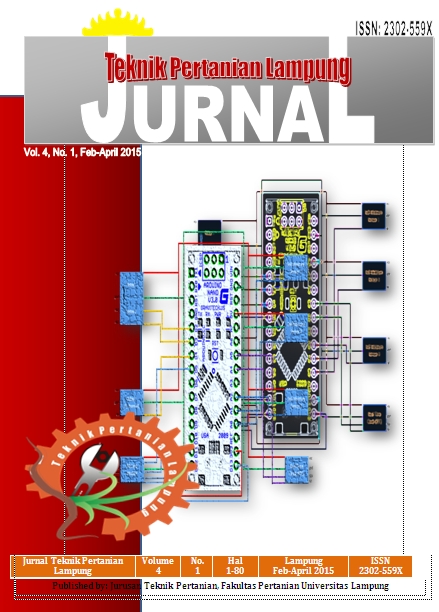DETERMINATION OF LAND TO POND RATIO IN RAIN WATER HARVESTING SYSTEM TO SUPPORT RICE-SOYBEAN CROPPING PATTERN
Abstract
The rain water harvesting system consists of a land area cultivated with rice and soybean cropping patternannually, and a rainwater collection pond. Surpluswater (runoff) in raining season is captured and collected in
the pond, and used for irrigation in the following cultivation. The objective of this researchwas to determine the
optimumratio of the landto pond area. This researchwas carriedout in the IntegratedField Laboratory, Faculty
of Agriculture, University of Lampung by using data of soil physical properties (water content, field capacity,
permanentwilting point, percolation); rice crop coefficient, soybean crop coefficient and climatological data for
13 years from1999 to 2011. Datawas processed using asimulation program(Visual Simulation)presented inthe
graphical form. The results showed that the rainwater potential that can be utilized as an alternative irrigation
is abundant, about 1500 mm/year - 3000 mm/year with a total of rainwater reaching 314.509,78 m3 over 13
years. Based on the simulation, the most effective period of planting, for rice is in January and for soybean is in
May. In addition, the optimum pond dimension to serve 1 ha cropping land is about 2450 m2 in with 3m depth,
or the ratio of land to pond is 4:1.
Keywords : Evapotranspiration,Pond,Rainwater harvesting,Rice and Soybean
Downloads
Published
2015-05-01
Issue
Section
Articles
License
- Authors who publish with this journal agree to the following terms:
- Authors retain copyright and grant the journal right of first publication with the work simultaneously licensed under a Creative Commons Attribution-ShareAlike 4.0 International Lice that allows others to share the work with an acknowledgement of the work's authorship and initial publication in this journal.
- Authors are able to enter into separate, additional contractual arrangements for the non-exclusive distribution of the journal's published version of the work (e.g., post it to an institutional repository or publish it in a book), with an acknowledgement of its initial publication in this journal.
- Authors are permitted and encouraged to post their work online (e.g., in institutional repositories or on their website) prior to and during the submission process, as it can lead to productive exchanges, as well as earlier and greater citation of published work (See The Effect of Open Access).
Jurnal Teknik Pertanian Lampung

JTEPL is licensed under a Creative Commons Attribution-ShareAlike 4.0 International License.

